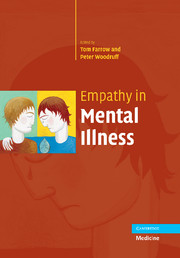Book contents
- Frontmatter
- Contents
- Foreword
- List of contributors
- Part I ‘Dysempathy’ in psychiatric samples
- 1 Empathic dysfunction in psychopathic individuals
- 2 Empathy deficits in schizophrenia
- 3 Empathy, antisocial behaviour and personality pathology
- 4 Empathy and depression: the moral system on overdrive
- 5 Empathy, social intelligence and aggression in adolescent boys and girls
- 6 Impaired empathy following ventromedial prefrontal brain damage
- 7 Non-autism childhood empathy disorders
- 8 Empathy and autism
- Part II Empathy and related concepts in health
- Part III Empathy models, regulation and measurement of empathy
- Index
6 - Impaired empathy following ventromedial prefrontal brain damage
from Part I - ‘Dysempathy’ in psychiatric samples
Published online by Cambridge University Press: 17 August 2009
- Frontmatter
- Contents
- Foreword
- List of contributors
- Part I ‘Dysempathy’ in psychiatric samples
- 1 Empathic dysfunction in psychopathic individuals
- 2 Empathy deficits in schizophrenia
- 3 Empathy, antisocial behaviour and personality pathology
- 4 Empathy and depression: the moral system on overdrive
- 5 Empathy, social intelligence and aggression in adolescent boys and girls
- 6 Impaired empathy following ventromedial prefrontal brain damage
- 7 Non-autism childhood empathy disorders
- 8 Empathy and autism
- Part II Empathy and related concepts in health
- Part III Empathy models, regulation and measurement of empathy
- Index
Summary
Introduction
The study of the neurobiological bases of social cognition is currently one of the most prominent areas of research in behavioural neurology and in neuropsychology. Similar to many other areas of contemporary neuropsychological research, it was first characterized by single case reports of patients suffering from brain damage. One of the first descriptions of impaired social cognition following brain damage was provided by Harlow (1868). In his famous case report, Harlow portrays the case of Phineas Gage, a railroad employee, who suffered severe frontal lobe injury due to an iron bar that penetrated his frontal lobes. Although he survived, recovered physically and had many preserved cognitive abilities, his social behaviour was so impaired that his acquaintances said he was ‘no longer Gage’. Harlow does not refer directly to Gage's empathic ability yet he describes him as ‘… fitful, irreverent, indulging at times in the grossest profanity, manifesting but little deference for his fellow …’ (Harlow, 1868). In the following years, similar clinical reports have offered accumulating evidence regarding the role of the frontal lobes in emotions and behaviour regulation, and the past 10 years have seen tremendous resurgence of interest in this area. Studies have consistently suggested that acquired damage to the prefrontal cortex may result in severe impairment in interpersonal behaviour (Damasio et al., 1991; Mesulam, 1985; Stuss and Benson, 1986; Stuss et al., 2001).
- Type
- Chapter
- Information
- Empathy in Mental Illness , pp. 89 - 110Publisher: Cambridge University PressPrint publication year: 2007
- 5
- Cited by



